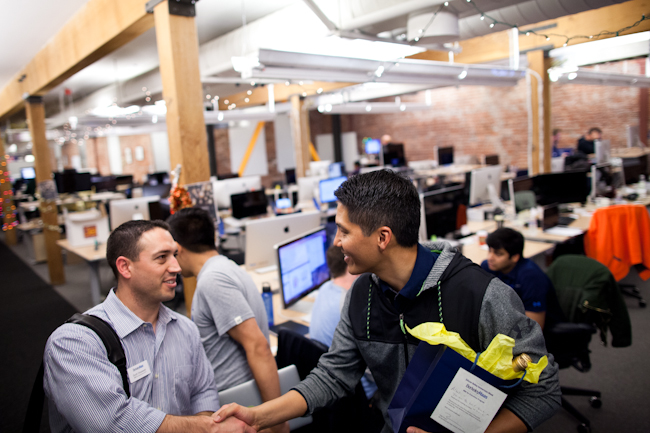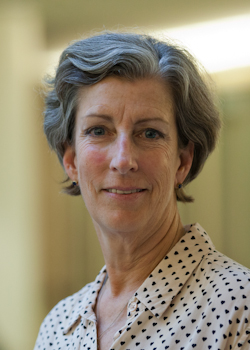
Haas EMBA student Scott Olszewski (left) says goodbye to MyFitnessPal co-founder Albert Lee in San Francisco – Ethan Baron photo
These days, there’s something very different about the world’s most famous tech hub: its footprint. Silicon Valley is now too big for Silicon Valley. It’s spilling out from its traditional center – Palo Alto, Menlo Park, Mountain View, Cupertino, Sunnyvale – and taking over new territory, transforming the San Francisco Bay Area into a vast technopolis, with the furious innovation of corporate giants such as Google, Apple, and Facebook matched in energy if not in scale by legions of new ventures, located increasingly to the north, up the Peninsula, and in San Francisco and beyond.
When assessing growth in the startup arena, you could look at, say, the Kauffman Index and you’d see that in 2015, a downward U.S. trend in startup activity that started in 2010 during the recession rebounded for the first time, with the largest year-over-year increase in two decades. But a more telling picture emerges when you examine the rapid expansion of Silicon Valley from its original area all the way north to San Francisco and beyond. And there may be no better way to do that than to travel along during this year’s U.C. Berkeley Haas School of Business executive MBA Silicon Valley Immersion program, which unlike in past years, spent a considerable portion of the week outside the Valley proper.
Yes, the EMBA students visited ventures in the Silicon Valley heartland: the U.S. defense department’s innovation and experimentation unit in Mountain View; famed VC and PE firm Andreessen Horowitz on Sand Hill Road in Menlo Park; the Xapo bitcoin-wallet startup in Palo Alto; professional networking platform maker Accompany in Los Altos; digital news magazine Ozy in Mountain View; and a handful of other companies within the traditional – but now obsolete – geography of the global tech and innovation hub.
VISITING STARTUPS FROM STEALTH MODE TO SNAPPED UP
Students attended at startups in varying stages, from stealth to already-sold-for-untold-millions, and for the first time in its three years, the Haas EMBA Silicon Valley Immersion Week has taken place mostly to the north. Of the 28 firms visited by the 69 students, only seven were within the traditional Silicon Valley boundaries, while four were to the north on the Peninsula and 16 were in San Francisco. Last year, the split between the Valley proper and the greater technopolis was half and half. In 2013, students in the inaugural immersion visited 20 companies in the Valley, and eight in San Francisco.

Jamie Breen, Haas EMBA program director of strategic planning and operations – Ethan Baron photo
“We’ve been moving north as the startup ecosystem moves north,” says Mike Rielly, assistant dean of the Berkeley MBA for Executives Program at Haas. “Talk with anyone about the explosion of startups, they’re increasingly up the Peninsula, San Francisco, the East Bay, and now Marin. What’s great about these field immersions is we adapt. It’s all very just in time, it’s very current.”
Still, 60% to 75% of Haas EMBA students will never become entrepreneurs. So why spend a week visiting startups? Because, says Jamie Breen, Haas EMBA program director of strategic planning and operations, the abilities needed at innovative new companies are also required in large established firms. “They’re all looking for entrepreneurship skills because they’re all at risk of being disrupted,” Breen says. “Every large company wants that skill set in its leaders.”
For Toby Stuart, the star Haas entrepreneurship professor (former prof at the Harvard, Columbia, and University of Chicago business schools), several entrepreneurial skills cut across the business spectrum, most particularly the ability to sell, which applies to everything from recruiting, employment contract negotiations, pitches, and financing terms, he says. Strong leadership capacity, and “proactivity” are two other entrepreneurship hallmarks crucial to effectiveness in business in general, Stuart says.





Questions about this article? Email us or leave a comment below.